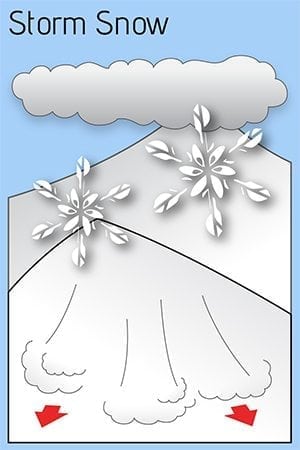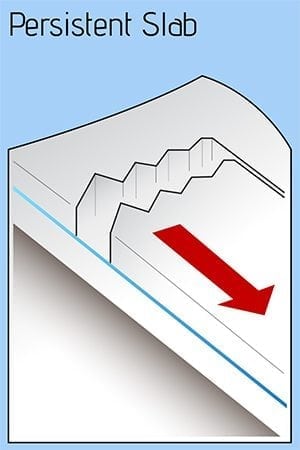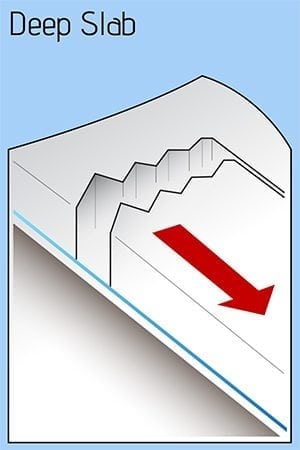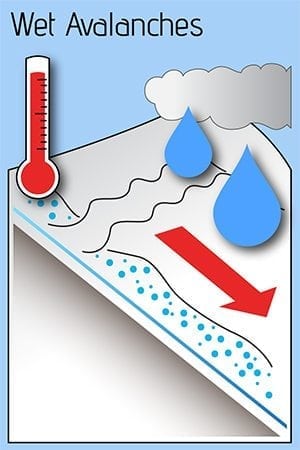Valdez
Above 4,000ftModerate
2,000 to 4,000ftModerate
Below 2,000ftModerate
Degrees of Avalanche Danger
Avalanche Problems
Problem 1
A small storm over the last 24 hours has delivered a minor refresh to our area with upper elevations of Valdez receiving 4-6 inches, Thompson Pass 2-3 and 46 mile a dusting. Expect to find greater snowfall amounts at upper elevations and shallow storm slabs that may be initially sensitive in steep terrain. Areas that are wind loaded and/or convex terrain will be the most sensitive. Additional accumulations are expected to be minimal as the current storm rolls out.
This new snow is falling on a variety of snow surfaces, ranging from hard wind slabs, refaceted wind affected snow (orange peel) and old powder. Sensitivity of the new snow may vary depending on what surface the new snow falls on. For example: areas where very hard wind affected snow was previously in place may act as a low friction bed surface and the new snow may not bond well initially.
Hand pits and small test slopes are a good tool for determining how well the new snow is bonding to the variable snow underneath. New storm slabs are expected to be deeper in areas to the south and east of Thompson Pass. Areas to the north of Thompson Pass received little to no new snow, new storm slabs will not be present in those areas.
Likelihood:
- Almost Certain
- Very Likely
- Likely
- Possible
- Unlikely
Size:
- Historic
- Very Large
- Large
- Small
Trend
- Increasing
- Steady
- Decreasing
Problem 2
The sensitivity of layers within the Hamilton storm snow (3/17) and the 3/17 interface have been decreasing. Low sensitivity to skiers and snowmachiners traveling in steep terrain as well as positive results in stability tests are all pointing to a low likelihood of triggering an avalanche at these layers. Some large human triggered and natural avalanches have been reported although it has been over a week since these occurred, and all of these were outside of our forecast zone. Even though the likelihood is low, it is still important to asses the depth and sensitivity of potential weak layers in the snowpack when deciding to travel in steep and/or consequential terrain.
Wind slabs that formed on 3/25 have been found to be unreactive. Although there is still the small chance for small pockets to be reactive in steep rocky terrain where they overlie facets. Remember that even small avalanches can have big consequences in steep and/or exposed terrain.
Likelihood:
- Almost Certain
- Very Likely
- Likely
- Possible
- Unlikely
Size:
- Historic
- Very Large
- Large
- Small
Trend
- Increasing
- Steady
- Decreasing
Problem 3
Weak snow exists at the base of our snowpack. This weak snow is currently unlikely to be affected due to the strength of old wind affected snow at the 3/17 new/old interface. Depth hoar may become a concern later in the season if our area returns to a period of major snowfall and the very strong wind damaged layer at the new/old interface starts to break down and lose strength within the snowpack. As very hard wind slabs break down within the snowpack a person or machines weight will have a more direct affect on weak layers at the bottom of the snowpack. In addition, the increasing intensity of the sun will be putting pressure on deep layers during the heat of the day.
Likelihood:
- Almost Certain
- Very Likely
- Likely
- Possible
- Unlikely
Size:
- Historic
- Very Large
- Large
- Small
Trend
- Increasing
- Steady
- Decreasing
Problem 4
Wet loose avalanches may become possible on south and west aspects below 4000′ if the sun is able to peak through the clouds today. Avoid exposing yourself to steep solar aspects where the surface snow is becoming moist-wet during the heat of the day. New snow on 3/29 will easily be affected if the sun comes out during the day.
Likelihood:
- Almost Certain
- Very Likely
- Likely
- Possible
- Unlikely
Size:
- Historic
- Very Large
- Large
- Small
Trend
- Increasing
- Steady
- Decreasing
Avalanche Activity
Below is a summary of observed Avalanche activity from the last 7 days. Avalanches that were noted earlier in the season can be viewed by clicking the link below.
If you trigger or observe an avalanche consider leaving a public observation.
3/24- Ski cuts were reported as being productive, with avalanches up to D2 at the 3/21 interface.
3/18-21- Several D1-D2 human triggered avalanches have been reported. For the most part these have been outside our forecast zone and appear to be more likely in areas with either a weaker underlying snowpack (continental zone) or where storm totals were higher (SE of Thompson Pass). Remote triggers have also been reported as the Hamilton storm slab has settled and gained cohesion.
3/17- Multiple D1-D2 natural storm slab avalanches were reported and observed along the road corridor. These all failed within the storm snow with the exception of one deep persistent avalanche reported on Billy Mitchell.
Weather
Check out our updated weather tab! A collection of local weather stations are available for viewing with graphs and tabular data included.
NWS Watches, warnings and advisories
NONE
NWS Point forecast for Thompson Pass
Date Friday 03/31/23 Saturday 04/01/23 Time (LT) 04 10 16 22 04 10 16 22 04 Cloud Cover OV OV OV OV BK BK SC SC BK Cloud Cover (%) 90 85 80 70 60 50 45 30 60 Temperature 22 23 28 24 18 18 24 16 11 Max/Min Temp 29 16 24 10 Wind Dir NE NE NE NE NE NE NE NE NE Wind (mph) 11 12 11 13 17 18 20 16 6 Wind Gust (mph) 40 42 34 Precip Prob (%) 20 10 30 20 5 5 0 0 5 Precip Type S S S S 12 Hour QPF 0.03 0.03 0.00 0.00 12 Hour Snow 0.0 0.0 0.0 0.0 Snow Level (kft) 0.0 0.0 0.1 0.0 0.0 0.0 0.0 0.0 0.0
Click on link below for Thompson Pass weather history graph:

| Date:
03/31 |
24 hr snow | HN24W* | High temp | Low temp | 72 hour SWE* | March snowfall | Seasonal snowfall | Snowpack Depth |
| Valdez | ~2 | N/O | 36 | 25 | 0 | 19 | 236 | 51 |
| Thompson Pass | ~2 | N/O | N/O | N/O | N/O | 60 | 428 | N/O |
| 46 mile | Trace | 0 | 37 | 24 | 0 | 33 | ~115** | 54 |
*HN24W- 24 hour Snow water equivalent in inches
*SWE– Snow water equivalent
**46 mile seasonal snowfall total begins December 1st.
Additional Information
Click on the link below for a running summary of the seasons weather history.
Announcements
The avalanche hazard is moderate at all elevations. 2-6 inches of new snow at upper elevations has formed shallow storm slabs. Human triggered avalanches are possible up to one foot in depth. Watch for signs of shooting cracks, collapsing and avalanche activity that would indicate unstable snow.
Posted by Gareth Brown 03/31 8:00 am.
For a description of current avalanche problems, weather information, season history and more click the (+ full forecast) button. Avalanche forecasts will be issued Wednesday-Sunday.
If you have pictures of recent natural or human triggered avalanches or notice signs of instability such as shooting cracks or collapsing, leave an observation to help improve forecast accuracy.



